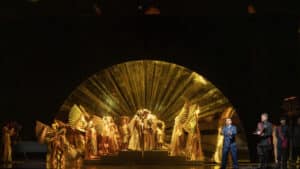Our roving critic Susan Hall went to see John Adams’ version of Antony and Cleopatra at the Metropolitan Opera. No-one there seems to remember the Samuel Barber opera that opened the new Met in 1966.
Here’s Susans’s take:
John Adams’s Antony and Cleopatra completes a commissioning trifecta. After its world premiere in San Francisco and a stop in Barcelona, this new take on Shakespeare’s iconic lovers now arrives at the Metropolitan Opera.
This is the first opera in which Adams takes solo responsibility for the libretto, drawing on long-dead collaborators: Shakespeare, Plutarch, and Virgil. Adams calls the result a “sung drama.” The work departs from traditional arias and duets, instead relying on the rhythms of Shakespearean language and the emotional turmoil of its central couple.
At the opera’s outset, a second triumvirate—Antony, Caesar, and Lepidus—rules the known world. Lepidus soon disappears from the scene. Antony invites Cleopatra to join him as co-ruler of Egypt, but to solidify ties with Caesar, he marries his sister Octavia, even though his heart belongs to Cleopatra.
Hollywood’s portrayal of the couple influences the production. Flashbulbs pop at every public appearance of the celebrity politicians. A large image of Julia Bullock as Cleopatra evokes Elizabeth Taylor’s portrayal in Cleopatra, complete with the iconic Egyptian headdress. In Charlton Heston’s film version, Octavia is cold—perhaps explaining, or at least forgiving, Antony’s swift return to Cleopatra in Alexandria.
The symphonic score demonstrates Adams at the peak of his powers. Conducting his own work, he delivers tonal and key shifts, varied rhythms, and a surprising touch—a Hungarian zither—that adds spice to the orchestration. One slight glitch in the revolving stage brought to mind the Met’s inaugural production of another Antony and Cleopatra, by Samuel Barber, in which the turntable failed entirely. Adams deliberately avoided listening to Barber’s version to steer clear of influence. Both composers, however, use martial beats to evoke the front lines of battle—Barber with booming drums, Adams with marching double basses, horns, and lighter percussion.
The opera’s heart lies in the modern emotional tensions between Antony and Cleopatra, driven by both lust and power. What motivates Antony more—his desire for Cleopatra or his duty to his soldiers? The opera grapples with the balance between domestic and public life. Adams’ music intriguingly presents both realms, but leaves the questions unresolved—tangled like the characters themselves.
The lead roles were written for soprano Julia Bullock (Cleopatra) and bass-baritone Gerald Finley (Antony), both of whom are currently performing at the Met. Bullock brings richness to her lower register and dramatic flair to her soaring highs. Finley, always a commanding actor, masterfully handles the vocal demands. Paul Appleby completes this triangle as Caesar, relishing the chance to portray an incarnation of evil—an unusual role for a tenor, typically cast as the hero.
Cleopatra is not simply a seductress; she’s a clever and commanding leader, surrounded by her two closest female advisors and a chorus of seraglio-style beauties. She is as beloved by her people as Antony is by his men. When Antony, devastated after his loss to Caesar at the Battle of Actium (a battle he was ill-suited for and urged into by Cleopatra), decides to kill himself, his soldiers refuse to assist him. He botches the job. Like life itself, this opera captures both the best and the worst of times.
The Met’s staging is visually rich, suggesting 1930s Europe, with the rise of fascism as a modern parallel to Caesar’s imperial ascent. The period costumes don’t feel out of place—in fact, opera singers may look even better in suits than togas. Though the temporal displacement isn’t strictly necessary, it underscores the timelessness of the story’s themes.
The sets and particularly the video projections by Mimi Lien and Bill Morrison are dynamic and illuminating. Much of the action is conveyed through visual storytelling and backdrops. Elkhannah Pulitzer directs.
The orchestra bristles with energy, shifting keys and maintaining a spirited drive. Yet, for all its brilliance, there’s a noticeable lack of erotic passion. Perhaps the opera’s intellectual precision leaves little room for the unrestrained emotional intensity that the story demands.
Adams has acknowledged his preference for writing shorter operas, believing that American audiences lack the attention span for longer works. Antony and Cleopatra might have benefited from more time — not in composition, but in allowing its emotional depth to fully unfold.
The post The Met’s second stab at Antony and Cleopatra: first night review appeared first on Slippedisc.








